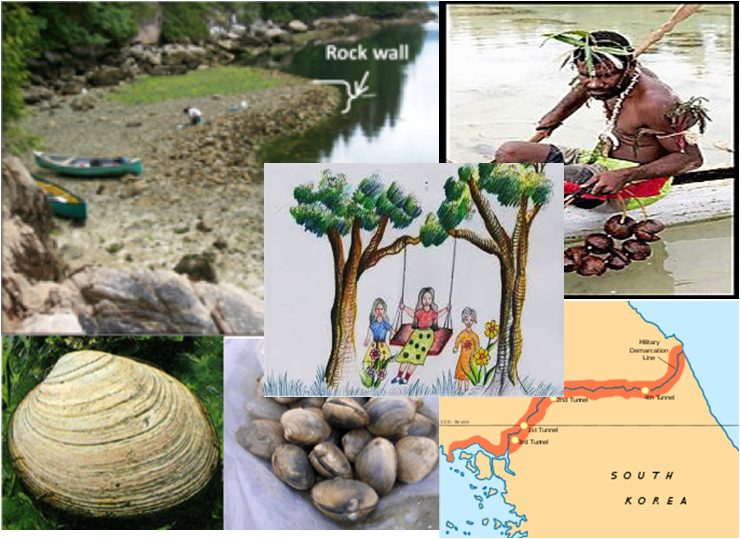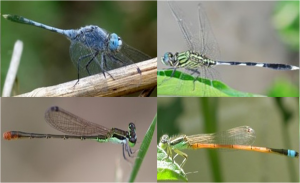Coconut shell: the death bell for sharks
The coconut tree is synonymous with sea beach and island nations. The tree is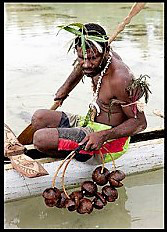 present across the tropics and it has diverse economic, environmental, and social relations with the communities. One such interesting use is in “Shell Rattling” where a bunch of coconut shells loosely attached through a string is used for luring sharks for hunting. In the islands of Papua-new Guinea, local fishermen use “Larung”/”Tui-ipu” made of coconut shells, to make sounds similar to cries of sea-birds around small fishes or traveling horse mackerel fishes. This rattling sound in the water attracts shark towards the spot and fishermen catch them with a noose attached to a curved stick.
present across the tropics and it has diverse economic, environmental, and social relations with the communities. One such interesting use is in “Shell Rattling” where a bunch of coconut shells loosely attached through a string is used for luring sharks for hunting. In the islands of Papua-new Guinea, local fishermen use “Larung”/”Tui-ipu” made of coconut shells, to make sounds similar to cries of sea-birds around small fishes or traveling horse mackerel fishes. This rattling sound in the water attracts shark towards the spot and fishermen catch them with a noose attached to a curved stick.
Photo: Eric Lafforgue
Collector: Rajasri Ray
Rajo Parbo – Monsoon celebration through menstruation
From the end of May, India is looking hungrily towards the Arabian Sea and the Bay of Bengal for its eternal ecosystem manipulator – the monsoon. The advent of monsoon is celebrated across the country through various festivals to express human gratitude towards nature for supporting their survival. 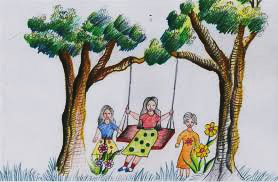 This transition from scorching summer to rejuvenating rainy season has a pivotal role in agriculture as the soil gets its required moisture, micro-organisms stimulate normal nutrient cycling and there is a boost for young members to grow. In Odisha, this natural phenomenon is linked with one of the vital events of the human life, i.e., menstruation and is celebrated through Rajo Parbo or Raja Festival. As menstruation indicates shedding of the unused eggs and associated tissues from the woman body to render it ready for fresh egg formation cycle; the analogy is drawn with mother earth’s rejuvenation during this seasonal transition. This three-day long festival is dedicated to ‘Vasumati’, the Earth goddess. It is believed that during the first 3 days of the festival mother earth goes through menstruation shedding past scorching experiences of summer and prepare herself for coming period of reproduction, i.e., cultivation and harvesting. At the 4th or last day, a ritualistic bath has been conducted (Vasumati Gadhu or the ritual bath of Bhu Devi) to indicate the end of natural menstruation for mother earth.
This transition from scorching summer to rejuvenating rainy season has a pivotal role in agriculture as the soil gets its required moisture, micro-organisms stimulate normal nutrient cycling and there is a boost for young members to grow. In Odisha, this natural phenomenon is linked with one of the vital events of the human life, i.e., menstruation and is celebrated through Rajo Parbo or Raja Festival. As menstruation indicates shedding of the unused eggs and associated tissues from the woman body to render it ready for fresh egg formation cycle; the analogy is drawn with mother earth’s rejuvenation during this seasonal transition. This three-day long festival is dedicated to ‘Vasumati’, the Earth goddess. It is believed that during the first 3 days of the festival mother earth goes through menstruation shedding past scorching experiences of summer and prepare herself for coming period of reproduction, i.e., cultivation and harvesting. At the 4th or last day, a ritualistic bath has been conducted (Vasumati Gadhu or the ritual bath of Bhu Devi) to indicate the end of natural menstruation for mother earth.
The festival emphasizes on unmarried young girls (who have attained puberty) to celebrate their time freeing from daily household jobs. They can enjoy song, dance, games, various foods and other joyous activities which otherwise is not possible in the day to day work. Synonymous with that, all agricultural activities are banned at this time period to put the earth at rest. After the 4th day, the normal agricultural schedule starts as usual. In the present time, it is one of the most popular and commercially attractive festivals to the retail, entertainment and food industry.
Photo: www.orissacards.com
Collector: Rakesh Mitra
Development: a challenge for food security?
We often use the term development as a panacea for our materialistic achievement. However, the idea is not as pleasant as it sounds especially for indigenous people. Apart from social, political and economic aspects, it is deep rooted in the food security especially for marginalized peoples. Development is synonymous with displacement for them which actually implies dissociating them from their land, on which they not only grow food or procure resources, it is their lifeline of very existence. It affects their choice of foods, connection with the indigenous food system and traditional knowledge linked to food etc.. They are excluded from the rights of accessing the local foods in one hand. On the other hand, the inept rehabilitation programmes rob off the sense of self-reliance – the cornerstone of food sovereignty from the lives of the displaced people. This traumatic experience around the world ultimately contributes towards homogenization of food cultures, loss of traditional wisdom and diversity and hegemony of corporate-centric food production system.
Collector: Sudeshna Dutta
Ancient garden growing clam trees
Humans, the great ecosystem engineer, have been altering, exploiting, and managing marine and terrestrial ecosystems for millennia. 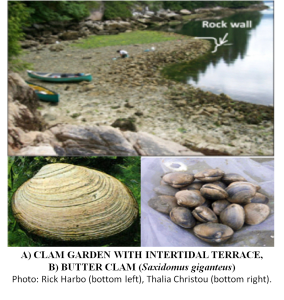 On one hand, fishing in coastal ecosystems has caused declines in key species; on the other, many demonstrate sustained yields. Recent records from archaeology and oral history tell us fascinating accounts of the First People around the world – who enhanced nearshore ecosystems maintaining and increasing productivity. No wonder, ancient people of Canada and Alaska used to construct and manage natural aquatic gardens, such as intertidal rock-walled terraces to grow their aquaculture business. A long list of the menu included a range of succulent bivalves, native littleneck, butter clams, horse clams, heart cockles. The study demonstrates their choice of artificial aquatic gardens had significantly shallower slopes than non-walled beaches and it enhanced clam food procurement more efficiently than any other nearby place. So, we learn a lesson on how ancient shellfish aquaculture practices may have supported food security strategies in the past; and also how it can offer clues to conservation, management, and governance of intertidal seascapes today.
On one hand, fishing in coastal ecosystems has caused declines in key species; on the other, many demonstrate sustained yields. Recent records from archaeology and oral history tell us fascinating accounts of the First People around the world – who enhanced nearshore ecosystems maintaining and increasing productivity. No wonder, ancient people of Canada and Alaska used to construct and manage natural aquatic gardens, such as intertidal rock-walled terraces to grow their aquaculture business. A long list of the menu included a range of succulent bivalves, native littleneck, butter clams, horse clams, heart cockles. The study demonstrates their choice of artificial aquatic gardens had significantly shallower slopes than non-walled beaches and it enhanced clam food procurement more efficiently than any other nearby place. So, we learn a lesson on how ancient shellfish aquaculture practices may have supported food security strategies in the past; and also how it can offer clues to conservation, management, and governance of intertidal seascapes today.
Source: Groesbeck et. al (2014) PLoS ONE 9(3): e91235. doi:10.1371/journal.pone.0091235
Collector: Avik Ray
Conflict zone and biodiversity
Conflict zones are areas between two countries/within the country, where sovereignty issue has a great dispute and often are guarded by armed forces of respective nations. These are no-man’s land where ordinary citizens are barred from entry and activities. Despite this negative notion, no-man’s land has some positive impact on the promotion of regional biodiversity.  A good example is the Korean Demilitarised Zone (DMZ). It is a 4 km wide 250 km long natural land area running through the border of North and South Korea. Knowing as one of the tense borders of the world, this area has lowest human presence hence lowest disturbance from modern civilization. This humanized isolation to the region has prompted an involuntary national park like scenario in the area. Added the benefit of natural topography rivers, mountain, swamp, lake and tidal marshes the region supports a good number of life forms. The reported species diversity equates 67% of the diversity in the Korean peninsula and the region is home to some of the rare animals like the red-crowned crane, white-naped crane, Siberian tiger, Amur leopard, and Asiatic black bear. Moreover, the region acts as an important resting area for north-south migration route of the crane populations.
A good example is the Korean Demilitarised Zone (DMZ). It is a 4 km wide 250 km long natural land area running through the border of North and South Korea. Knowing as one of the tense borders of the world, this area has lowest human presence hence lowest disturbance from modern civilization. This humanized isolation to the region has prompted an involuntary national park like scenario in the area. Added the benefit of natural topography rivers, mountain, swamp, lake and tidal marshes the region supports a good number of life forms. The reported species diversity equates 67% of the diversity in the Korean peninsula and the region is home to some of the rare animals like the red-crowned crane, white-naped crane, Siberian tiger, Amur leopard, and Asiatic black bear. Moreover, the region acts as an important resting area for north-south migration route of the crane populations.
Photo: Wikipedia
Collector: Rajasri Ray

